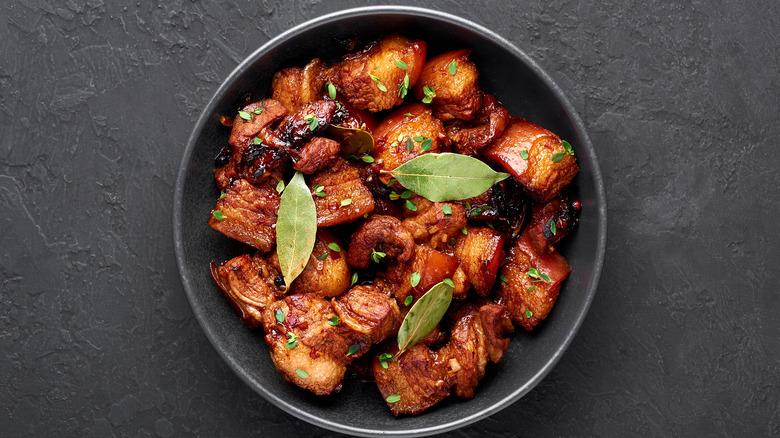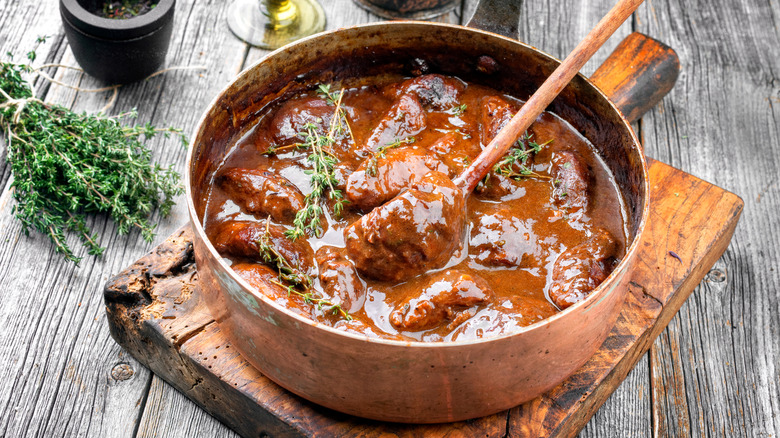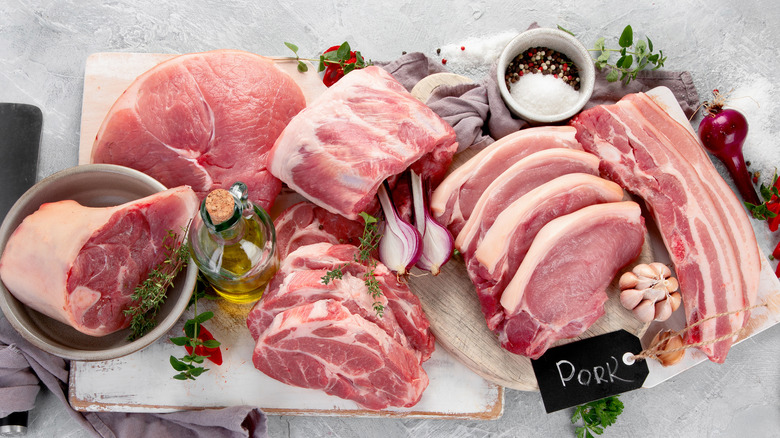What Cuts Of Pork Are Best For Braising?
Braising, a method involving searing and slow cooking in a relatively low temperature bath of liquid, is typically thought of as the domain of cold, dreary days spent indoors. It is a culinary antidote to winter blahs, contributing warmth throughout the cooking process and perfuming the kitchen and beyond with deep, heady aromas.
But, we'll admit it; we're suckers for a good braise year round. It could be a chicken gradually melting into coq au vin, a sturdy, yet altogether luscious pot roast, or even a caramelized bulb of fennel. Braising, at its simplest, asks little of a cook other than patience, and promises to deliver a medley of flavors greater than the sum of the recipe's ingredients.
Despite there being a seemingly-endless cavalcade of recipes that employ braising to transform an equally-endless seeming menagerie of ingredients, there is one protein that seems to be destined almost by design for the braising pot: pork.
With so many unctuous, muscular cuts, pork doesn't just need braising, it practically begs for it. While it is true that a variety of low-and-slow cooking methods can tame tough pieces of pork, braising is one of the most approachable, one that offers an easy on-ramp to delectable dishes. What then are the best cuts of pork for braising?
What is braising?
First, it's important to understand the action of braising. As MasterClass explains, braising is a two-stage cooking process. First, the foodstuff to be braised is quickly seared at a high heat. Commonly referred to as "browning," this step promotes a color change indeed, but also a deepening of rich flavors and aromas known as the Maillard reaction. Culinary scientist Jessica Gavin lays out the technical specifics, explaining that the Maillard reaction "is a form of non-enzymatic browning that occurs in foods when proteins and/or amino acids chemically react with carbohydrates of reducing sugars." She further lays out how, in the presence of heat, this process is accelerated.
After searing, aromatics such as garlic, herbs, and mirepoix may be added, but what is essential is the introduction of the main cooking medium, which technically could be just water, but is often a flavorful liquid, such as stock or wine. Again, often, but not always, the braising liquid is introduced to the same vessel in which the searing took place, thus deglazing or loosening bits of food stuck in place by the earlier searing (via Bon Appétit.) And you can rightly assume that as the Maillard reaction promotes a profound transformation of flavors, these little morsels are flavor bombs. You want them — nay, need them — swimming about in your braise.
Picking your pork
Now that we know what braising is, we need to know what to braise. While the technique can be applied to any number of ingredients, it is most commonly used to render tough cuts of meat tender. These cuts tend to be well-worked muscles, marbled with fat and connective tissue that must be slowly coaxed out, and, in so doing, contribute richness and the round mouthfeel that only they can provide (via The Spruce Eats.)
Two of the most popular pieces of pork to braise come from the foreleg: the upper Boston butt and the lower pork shoulder — adjacent, but confusingly named cuts, admits Cook's Illustrated. These hulking amalgamations of muscle are flavorful enough to not get "lost in the sauce," yet welcoming to other bold flavors, such as the orange, cumin, and chili powder in the carnitas recipe.
A little further down the pig, we come to the ribs, often seen in roasting and smoking recipes. But the same qualities that make them apt for those preparations make them perfect for braising. The first choice to make is between smaller, leaner baby back ribs or fattier, meatier St. Louis or spare ribs (via Kitchn.) Baby backs cook quicker and spare ribs offer more bang for the buck, but both make excellent braising options. If you're looking for something outside-the-box, we recommend this recipe that employs sweet Manuka honey and umami-laden marmite.


